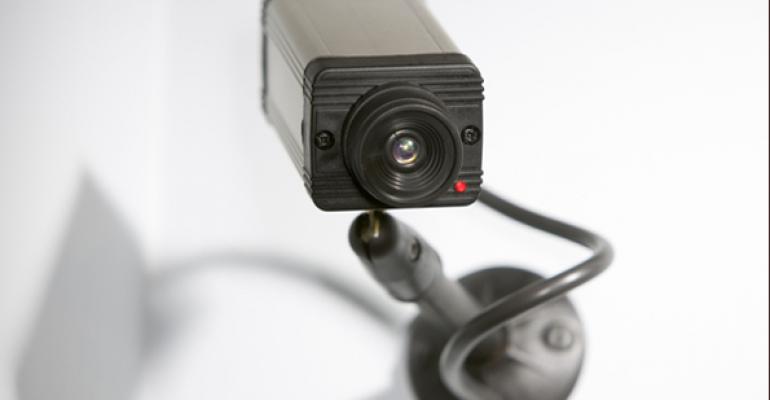The use of video surveillance as a service, or VSaaS, is a growing strategy within the restaurant industry used to improve security, manage costs and improve the customer experience at the restaurant level.
Restaurant chains like Eat’n Park and Popeyes Louisiana Kitchen serve as two recent examples of increased usage: Popeyes confirmed last week that it had concluded a near-three-year test of a digital video surveillance system at all 40 company-operated restaurants; and Eat ‘n Park made it a priority this year to update its video surveillance system to one hosted by a services provider offering increased access and direct ties to the point-of-sale system.
Video surveillance services providers work with restaurateurs, retailers, schools and government operations, among other businesses, that want to keep virtual eyes on facilities and their guests and employees. Their services can range from providing software for remotely accessing and analyzing video stored in older free-standing surveillance systems at multiple sites, to providing full, turnkey packages of the latest tools. Such packages may include video camera hardware; off-site storage of video data aggregated from multiple locations; and software for the centralized management and analysis of video data by chain operators.
RELATED
• Restaurants divided on mobile payments platforms
• Chefs extend brand with digital tools
• More restaurant industry operations news
IMS Research, an electronics market research and consulting firm, estimates that the fees paid to video surveillance services firms by small-to-medium-sized businesses in the Americas is expected to increase by 50 percent in 2012 to $75 million. IMS defines a small-to-medium-sized business as a non-residential property of 5,000 square feet or less, which can mean restaurants and cafes, gas stations, retail outlets or small offices. IMS Research’s Sam Grinter said his firm’s forecast of rapid growth in the use of VSaaS firms was based in part on the growing use by franchisees in the restaurant industry and other sectors.
Nation’s Restaurant News spoke with Eat ‘n Park director of safety and security Bill Moore to detail the Homestead, Pa.-based Eat’n Park Hospitality Group’s new VSaaS decisions. Eat ‘n Park operates 75 family-dining restaurants.
“My main reason for moving to a digital surveillance system is to help protect us from liability issues,” Moore explained.
“In today’s world, you need a strong defense,” he said. Threats or potential liabilities can range from employee or patron slip-and-fall-injury claims, incidences of alleged food adulteration, back-of-house supply thefts, cases of larcenous cashiers, and even sophisticated short-change artists who can confuse and cheat honest employees.
“Our security cameras provide that defense,” Moore said, “but we are finding out that they also provide a great offense, [as] we are able to see problems moments after they happen and we can adjust companywide in that moment.” At Eat ‘n Park, not all units get a full contingent of the video surveillance devices, Moore explained. Those that do have video cameras in a number of places, including dining rooms, managers’ offices, back-of-house areas, coolers, hallways outside bathroom, lobbies, front sidewalks and back doorways. He reported that “some sites have five, some have 16.”
At Eat ‘n Park, not all units get a full contingent of the video surveillance devices, Moore explained. Those that do have video cameras in a number of places, including dining rooms, managers’ offices, back-of-house areas, coolers, hallways outside bathroom, lobbies, front sidewalks and back doorways. He reported that “some sites have five, some have 16.”
“We experienced a 15-percent reduction in ‘walk-outs,’” or situations in which guests are reported to have left without paying, “and an 18-percent reduction in cash shortages,” Moore said. “In restaurants which have cameras in the back of the house, we have also seen improved food costs.”
The new capabilities of the surveillance system included a camera-to-POS connection that lets Eat ‘n Park link video of register activity to transactions that raise red flags in exception reports, such as excessive voids or discounts. The link also helps with Payment Card Industry [data-security standards] compliance “because you have cameras on registers and you are videotaping card swipes,” Moore added.
The system upgrades recently helped Eat’n Park identify two alleged short-change artists who were working a number of the chain’s locations, collect visual evidence of their activities and alert employees to their appearances. Once notified, those store-level employees collected additional information about the suspected criminals, including the license number of their car, which, in turn, helped police make an arrest, Moore said.
And on several other occasions, he said, patrons who initially allege damages from incidences they said occurred in an Eat’n Park restaurant have backed off when informed of the existence of video records.
Moore said his chain’s video surveillance system is used by multiple departments.
“Our marketing and operations teams do use it to observe wait times and traffic flow [and] our facilities department uses it to make sure our parking lots are getting snow plowed to their expectations,” Moore said. “During Hurricane Sandy, it was great to be able to see what was going on at our locations and who did and didn’t have power even while we were closed.”
Moore characterized his company’s spend for video surveillance technology and services as “a great investment,” but he would not reveal the budget or costs. He added that the return on investment “is not a hard number, it’s about avoidance” of fraud, theft and potential liability lawsuits.
“We know we’ve won lawsuits because of it, but how much those lawsuits would have cost us [if lost], we’ll never really know,” Moore said.
Contact Alan Liddle at [email protected].
Follow him on Twitter: @AJ_NRN





